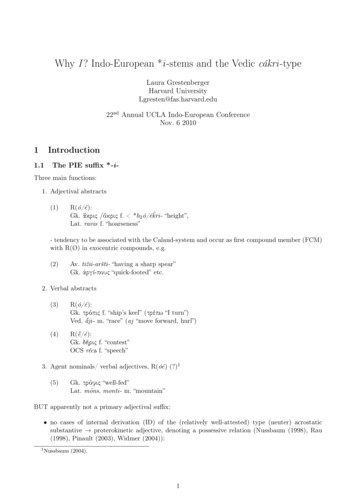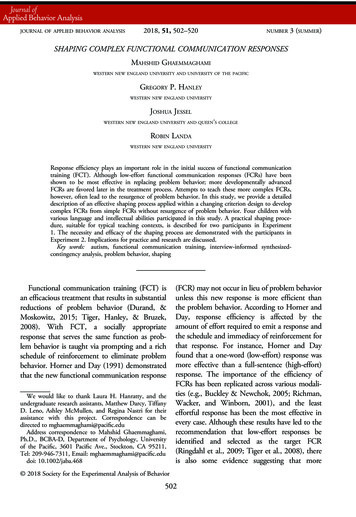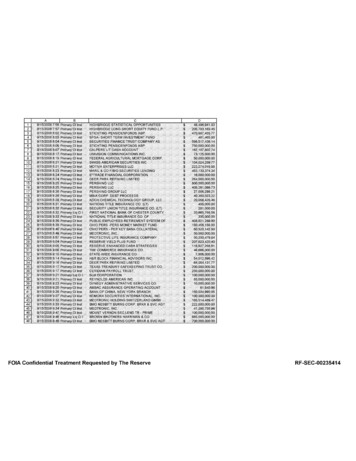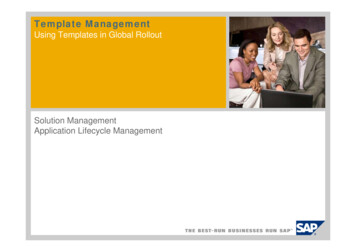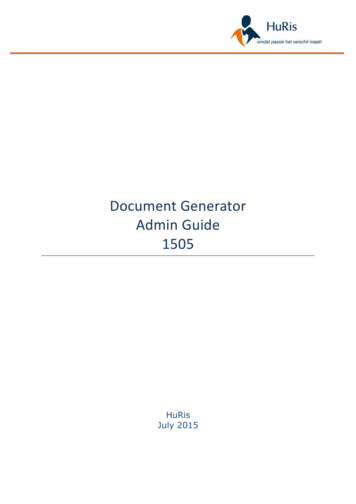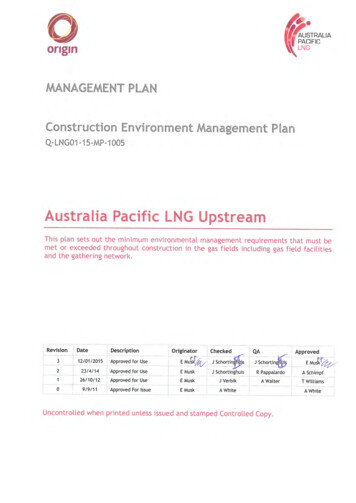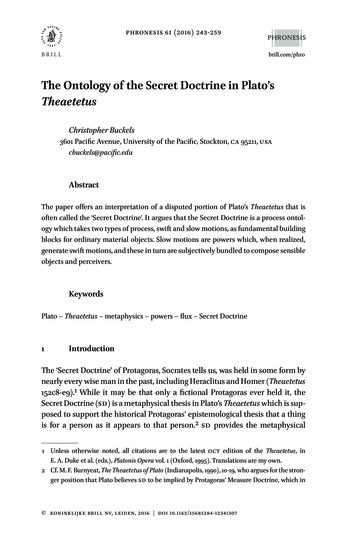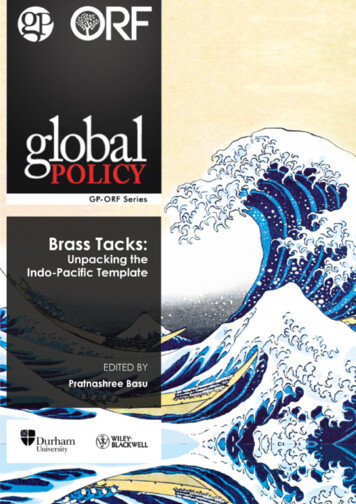
Transcription
2021 Observer Research Foundation and Global Policy Journal. All rights reserved. No part ofthis publication may be reproduced, stored in a retrieval system or transmitted in any form or by anymeans, electronic, mechanical or photocopying, recording, or otherwise, without the prior permissionof the publisher.Observer Research Foundation20 Rouse Avenue, Institutional AreaNew Delhi, India 110002contactus@orfonline.orgwww.orfonline.orgORF provides non-partisan, independent analyses on matters of security, strategy, economy,development, energy and global governance to diverse decision-makers including governments,business communities, academia and civil society. ORF’s mandate is to conduct in-depth research,provide inclusive platforms, and invest in tomorrow’s thought leaders today.Editing: Preeti Lourdes JohnDesign and Layout: Rahil ShaikhCover Image Source: Buyenlarge/Getty/Rights-managedISBN: 978-93-90494-38-5Citation: Pratnashree Basu, ed, Brass Tacks: Unpacking the Indo-Pacific Template, (New Delhi: ORFand Global Policy Journal, 2021).
Brass Tacks: Unpackingthe Indo-Pacific TemplateEdited byPrantashree Basu
ContentsEditor’s Note .7Geo-strategy: The Geometry of the Indo-Pacific Construct . The Indo-Pacific: From Theory to PracticeHarsh V Pant and Anant Singh Mann Intersections Between Free and Open Indo-Pacific and Other Regional TemplatesDavid Scott In Defence of the Indo-Pacific ConceptSanjay Pulipaka and Mohit Musaddi Chinese Checkers: Driving Alignments in the Indo-PacificShruti Pandalai Biden and the Indo-Pacific: Towards a ‘Leading From Behind’ StrategyKashish Parpiani Examining the EU’s Indo-Pacific StrategySwati Prabhu11Geoeconomy: Repercussions of Adaptive Expectations . Pandemic-Induced Supply Chain Disruptions: GeoeconomicReactions in the Indo-PacificSoumya Bhowmick and Suyash Das Competing Trade Architectures in the Indo-PacificNilanjan Ghosh For India, Autarky Is not an OptionDhruva Jaishankar Challenges to Blue Economy in the Indo-PacificAbhijit Singh Energy Security in the Indo-Pacific: Need for a Rules-Based Maritime OrderRoshan Saha and Pratnashree Basu57
Competing Polarities: Regional ordering and External Balancing . China’s Rise and Balancing in the Indo-Pacific: Taking Stock in 2021Jeff M. Smith Minilaterals in the Indo-Pacific: An Indian PerspectiveRajeswari Pillai Rajagopalan ASEAN and the Indo-Pacific: Managing the Impact of Regional Power ShiftsShankari Sundararaman Preserving ‘ASEAN Centrality’ in the Indo-Pacific: Challenges and PossibilitiesPremesha Saha The Andaman and Nicobar Islands: India’s Strategic Node in the Indo-PacificSohini Bose and Anasua Basu Ray Chaudhury100Analytics and Ambiguity: The Critical Technology Frontline . Towards a Free and Open Indo-Pacific Through Critical TechnologiesAarshi Tirkey Emerging Military Technologies and What They May Mean for the Indo-PacificJavin Aryan Securing the CyberspaceRatnadeep Chakraborty138About the Editor and Authors .163
Editor’s NoteSpanning a vast geographical expanse and covering twoocean systems, the Indo-Pacific comprises some of thefastest growing developing economies in the world,houses the most active seaports, and accounts for the bulk ofglobal maritime trade. Unsurprisingly, global and intra-regionalinteractions have come to be inextricably tied to the geopoliticaland geoeconomic realities and shifts in the Indo-Pacific. This partof the world has consequently come to occupy a place of significantmulti-stakeholder prominence across the globe, resulting in bothcooperative and competitive equations of power over access toand use of resources, connectivity, and infrastructure. While thepre-pandemic world was already grappling with geopolitical,geoeconomic and technological complexities, the onset of themost challenging global health crisis ever has propelled countriesaround the world into unanticipated uncertainties and acceleratedand recalibrated global interactions and decision-making inunprecedented ways. Underlying these interconnections is theuncertainty and ambiguity with respect to China’s place and rolegiven the significant proportions of apprehension that it has givenrise to.This volume of the GP-ORF Series will explore the currents thatcharacterise a geopolitically tense Indo-Pacific with the aim tountangle or decongest this geographical space, which has in a sensebecome encumbered by a multitude of strategic ascriptions andensuing policy prescriptions. The edition comprises four sectionsinquiring into the key developments and their perceived andEditor’s Note7
actual implications alongside considered approaches that informboth intra and extra-region interactions. Divided into the broadcategories of strategy, economy, regional politics and criticaltechnologies, these sections also offer policy directions in responseto shifts in the regional contour. The not-so-smooth rise of China;the increasing role of aspirational intra-regional countries; arenewed realisation of the significance of maritime commerce andits complex and multi-layered interaction with political dynamics;the reliance on maritime trade routes for supplies of energy and theuncertainties; and opportunities posed by rapid advances in criticaltechnologies are some of the key issues that underpin and shapedevelopments in the Indo-Pacific.The first section, ‘Geostrategy: The Geometry of the Indo-PacificConstruct,’ explores the many definitions and constructs for whatthe Indo-Pacific stands for—all of which are not equivalent—andhow they are impacting regional and global alignments of power.This section traces the evolution of the Indo-Pacific as a geostrategicconstruct and evaluates if the Indo-Pacific is a constructive projectwith the potential to bind a part of the world that is aspirationaland committed to the preservation of peace and stability, or if itis just a hastily put together construct that is grappling to bringtogether like-minded countries to contain China. This sectionanalyses the role of China, India and the US as Indo-Pacificpowers, key to the making and unmaking of regional and globalgeopolitical equations.The focus of the second section, ‘Geo-economy: Repercussionsof Adaptive Expectations,’ centres around the geoeconomicinteractions in the Indo-Pacific, exploring how economicengagements stand to characterise and impact the politically-heavydynamics of the region. It looks at how the ongoing pandemichas underscored the already acknowledged need for diversifyingreliance on traditional nodes of manufacturing alongside thebuilding of resilient supply chains; the ways in which competingarchitectures of trade and investment interact and influencebilateral and multilateral ties; and the imperative of cooperationin energy security particularly in the context of ensuring seamlesstrade flows across some of the busiest sea lines of communication,8Editor’s Note
which traverse the waters in the Indo-Pacific. India’s position andeconomic engagements, its characteristic trade dilemma and futurechoices for global integration is another aspect of consideration.Recognising the multi-dimensional challenges such as climatechange, sea-level rise, ocean acidification, and extreme weatherevents, this section also looks at emerging areas of collaboration thatare prompting countries to gravitate towards the ‘blue economicmodel’ of sustainable and viable growth.‘Competing Polarities: Regional ordering and External Balancing,’the third section, acknowledges that the Indo-Pacific is caughtbetween responding to developments and devising approachesthat are best suited to make room for the expanding scope ofexternal balancing in the region. Geopolitics will largely play outin this spectrum of cooperation and contest. In this background,this section investigates the challenges for operationalising ASEANcentrality in an already fraught Indo-Pacific; the mushrooming ofminilateral forums and whether they stand to achieve partnershipsof function especially as middle powers like Australia, Japan, andIndia begin to shoulder a larger share of intra-region securitydynamics; and the geopolitical tightrope that countries inSoutheast Asia must manoeuvre amidst regional and externalpulls and pressures. From the perspective of New Delhi, it assessesthe viability of utilising the Andaman and Nicobar Islands as aspringboard for India’s involvement in the Indo-Pacific.The final section, ‘Analytics and Ambiguity: The CriticalTechnology Frontline,’ studies whether critical technologies havebecome the new frontline in the Indo-Pacific. Digital responses arebecoming ever more critical, leading to the shrinking of physicaldistances and communication timelines and demanding responsesthat are adaptive and swift. The adoption of and adaptation totechnologies connected with the fourth industrial revolution,such as 5G, artificial intelligence, nanotechnology, roboticsand quantum technology, will define the nature and scope ofinnovation, economic progress and social development withincountries. With scope for both positive and negative disruptions,critical technologies offer opportunities for collaboration whilealso being susceptible for use as the tools of modern warfare. InEditor’s Note9
a region that is already witness to contested spaces, the role oftechnology becomes rife with opportunities and as countries in theIndo-Pacific frame their approaches to critical technology issuesthrough the lens of national security.This volume sets out to provide a meaningful template for theIndo-Pacific construct. In doing so, it highlights the primedrivers impacting countries in the region while also focusing onthe external forces that align with or affect the evolution of theIndo-Pacific, with the objective of informing stakeholders, policypractitioners and researchers with a comprehensive yet nuancedunderstanding of a region that will shape global interactions in thecoming years.Pratnashree Basu10Editor’s Note
GEO-STRATEGY:THE GEOMETRY OFTHE INDO-PACIFICCONSTRUCTGeo-strategy: The Geometry of the Indo-Pacific Construct11
The Indo-Pacific: FromTheory to PracticeHarsh V Pant and Anant Singh MannThe notion of a “broader Asia,” which for the first timeaimed to conflate the maritime belts of the Indian andPacific Oceans in a geopolitical context, was conceived informer Japanese Prime Minister Shinzo Abe’s famous “Confluenceof the Two Seas” (1) address to the Indian Parliament. Althoughthis abstract transition of the general approach to the region fromits previous ‘Asia-Pacific’ avatar appears rudimentary and generallylimited to certain groupings of states, its formulation and gradualglobal expansion do indeed signal a change in the power structuresof contemporary international relations.The transition of this terminology has further been juxtaposedwith the slow development of a strategic understanding betweenJapan, India, Australia, and the US in the form of the QuadrilateralSecurity Dialogue (Quad) and expressed more tangibly in the recentinclusion of Australia (2) in the 2020 Malabar naval exercises. (3)As a consequence of these developments, questions have been raisedregarding the motives behind the evolution in the description ofthis region. A variety of perspectives exist, but two are key. Firstis that of China, which pessimistically emphasises the existence12Geo-strategy: The Geometry of the Indo-Pacific Construct
of a zero-sum game in the region and warns the formation of a“new NATO” to counterbalance its rise in the region. (4) Second,scholars point out that a redefinition of the region as “one singlemaritime entity” is both conducive to and a result of the region’sgreat economic potential to function as a corridor strengtheningthe link between Southeast and South Asia. (5) Although bothnarratives provide unique perspectives on the advancement of theIndo-Pacific concept, to better understand its development it iscritical to analyse the evolution of circumstances and requirementsof the key states (the Quad countries).The “confluence” of the Indian and Pacific Oceans as a descriptionfor their shared maritime region has a significant historicalantecedent; it was proposed as early as 1865 that the region bedescribed as “Australindia”. (6) This parlance was only revived outof its dormancy after Abe’s famous speech in 2007. On the surface,the reasons for its renewal are manifold and include traditional andnon-traditional issues like terrorism, human trafficking, forcedmigrations, environmental concerns, and the substantial rise in thevalue of trade routes in the region. (7)While each of these developments warrant a reoriented focus onthe strategic combination of the Indian and Pacific Oceans, thepractical implementation of the phrase ‘Indo-Pacific’ in diplomaticnomenclature has indeed had its ups and downs over the last fewdecades. The needs and priorities of individual countries haveguided their strategic categorisation of the Indo-Pacific region.JapanJapan’s stance on the region has evolved from a competitive tocooperative strategy. (8) It started out by aggressively championingthe new ‘Free and Open Indo-Pacific’ (FOIP) strategy, (9) whichcrucially focused on ‘Asia’s Democratic Security Diamond’. Theidea of the security diamond inherently excluded China from theIndo-Pacific club, creating a clear schism in the region between USand China allies. The initial FOIP approach was to counterbalanceChina’s rapid rise by roping in the US and other middle powerslike India and Australia. In the post-2012 period, the focusshifted from securitising the Indo-Pacific to using its fundamentalprinciples of keeping a FOIP to bring “stability and prosperity”Geo-strategy: The Geometry of the Indo-Pacific Construct13
(10) to the international community. Currently, there appears to bea co-existence between the competitive and corporative strategies,as Japan continues to partake in the Quad and the Malabar navalexercises, as well as other security initiatives in the Indo-Pacific. Buteconomic factors and the Senkaku Islands dispute will continue todrive Japan’s position in the Indo-Pacific.IndiaIndia’s relationship with the Indo-Pacific construct is rooted in itsefforts to reach out to its east through its remodelled ‘Act East’policy. India’s security arrangements in the region have existedsince the beginning of the Malabar military exercises (in 1992)and the initial conceptualisation of the Quad (in 2007), but itsoutreach at the time was based on enhancing connectivity and tradeactivity in the region to emulate East Asia’s economic progress.(11) While the connectivity and trade aspects have not beencompletely disregarded, India’s emphasis on security, catalysed byan increasingly assertive China, has been particularly accentuatedover the last decade. (12)The Indo-Pacific arena remains a central feature in India’s Chinapolicy, but issues such as the commitment to a ‘strategic ambiguity’continue to plague any further advancement in its role in theregion. What has been described as an “evasive balancing” (13)has shaped India’s efforts at counterbalancing China’s assertivenessin the region while reassuring China of its nature of non-securityactivity in the region. Perhaps the most significant changes inthe Sino-Indian relationship took place during their prolongedmilitary standoff in 2017 at the Doklam border trijunction andconfrontation in 2020 at the Galwan Valley. (14)These events have emerged as turning points for India’s approachto the Indo-Pacific, uprooting many prior reservations aboutestablishing stronger regional engagement. India has established anew Oceania division in its foreign ministry, with the mandate tocoordinate and strengthen the country’s strategic outreach in theIndo-Pacific. (15) India’s central role in the Indo-Pacific strategytruly represents its coming of age, giving India the due recognitionof its enhanced role on the global stage.14Geo-strategy: The Geometry of the Indo-Pacific Construct
The USThe US saw a period of dormancy in its support of the phrase ‘IndoPacific’ and its associated principle of FOIP after 2007. Althoughthe US recognised the term Indo-Pacific, its usage and rhetoricof a FOIP visibly decreased under the Obama administration.Subsequently, the Trump administration officially switched fromthe ‘Asia-Pacific’ phrasing to the ‘Indo-Pacific’. (16) Under formerPresident Donald Trump, the US approach on the Indo-Pacificwas guided by the dual policy of reducing China’s unequal tradeadvantages and expanding its presence in the region under theFOIP banner. (17)The Trump administration openly declared in 2017 and again in2019 that “the Indo-Pacific nations face unprecedented challengesto their sovereignty, prosperity and peace”. (18) The US alsorecognised that “authoritarian revisionist powers” are activelyexpanding the schism between “free and repressive” systems,clearly alluding to its growing antagonism with China. (19) As alogical consequence, it has progressively adapted and championedthe usage of the Indo-Pacific as a description of the region.AustraliaAustralia has arguably remained the most ambivalent of the Quadnations, both in its adoption of the Indo-Pacific nomenclatureand in subscription to its underlining values—from Australia’sabrupt public withdrawal in 2008 from the Quad, (20) toextending reassurances to China in 2017 that it would continueto strengthen bilateral ties, and describing that country as a “majorgeopolitical player”. (21) Australia continues to maintain extensivedependencies and interlinkages with China, which is its largesttrading partner and export market. (22)Australia’s adoption of the Indo-Pacific nomenclature has anidiosyncratic emphasis on building an “open and prosperous IndoPacific” coupled with “strengthening and diversifying partnershipsacross the globe”. (23) However, this flexibility and proclivitytowards China has been questioned in the post-COVID-19 era. Atthe forefront was the alleged Chinese interreference in Australiandomestic politics in 2017. (24) Building from this antecedent wasGeo-strategy: The Geometry of the Indo-Pacific Construct15
a distinct assertiveness in China’s approach to its foreign policy,which was perhaps symbolised by its highhandedness in handlingthe relationship with Australia during the pandemic. (25)Disillusioned with China, Australia has sought a closer relationshipwith the other Quad countries, eventually participating for thesecond time in the annual Malabar naval exercises with India, theUS and Japan. (26)ConclusionThe prospect of an increasingly assertive China remains a keydriver for countries in the region rallying to protect shared normsand values under the banner of the Indo-Pacific. Apart fromthe Quad nations, the UK, France, the Netherlands, Germany,Indonesia, and the Association of Southeast Asian Nations havealready adopted the new nomenclature. (27) It is in this backdropthat China continues to make significant efforts to reverse the tideand discredit the idea of an Indo-Pacific. (28)The Indo-Pacific concept is not just about containing Chinaor functioning as a regional economic platform, but is a logicalconclusion to the evolving needs the countries in the region.Viewing the creation of the Indo-Pacific only through the ‘newNATO’ or ‘single maritime entity’ narrative is limiting as itoverlooks key regional and global complexities that could shape it.The Indo-Pacific construct and its associated values are here tostay. The Quad will only solidify as the needs and interests of thefour countries align further. What remains to be seen is how theremaining countries in the region react to this construct, whichwill have significant geoeconomic and geopolitical impacts.16Geo-strategy: The Geometry of the Indo-Pacific Construct
Endnotes:(1)Shinzo Abe, “Confluence of the Two Seas,” (speech, Parliament of the Republic of India, August 22, 2007, Ministryof Foreign Affairs of Japan, eech-2.html(2)Marise Payne, “Australia to Participate in Exercise Malabar 2020,” Department of Defence, Australian Government,October 19, 2020, malabar-2020(3)Harsh V. Pant and Anant Singh Mann, “India’s Malabar Dilemma,” Observer Research Foundation, ORF Issue BriefNo. 393 (2020), dilemma/(4)Wang Yi, “U.S. ‘Indo-Pacific Strategy’ Undermines Peace and Development Prospects in East Asia,” Ministry ofForeign Affairs of the People’s Republic of China, October 13, 2020, https://www.fmprc.gov.cn/mfa eng/zxxx 662805/t1824140.shtml(5)Shankari Sundararaman, “Indo-Pacific Economic Corridor: A Vision in Progress,” Emerging Trans-RegionalCorridors: Perspectives from South and Southeast Asia, eds. K. Yhome and Rajeev Ranjan Chaturvedy (New Delhi:Observer Research Foundation, 2017), pp. 26–33, 01/GPORF-Transregional-Corridors.pdf(6)Rory Medcalf, Indo-Pacific Empire: China, America and the Contest for the World’s Pivotal Region (Manchester:Manchester University Press, 2020), p. 31(7)Dewi Fortuna Anwar, “Indonesia and the ASEAN Outlook on the Indo-Pacific,” International Affairs 96.1 (2020):111–129, 04?login true(8)Yuichi Hosoya, “FOIP 2.0: The Evolution of Japan’s Free and Open Indo-Pacific Strategy,” Asia-Pacific Review 26.1(2019): 18–28, 06.2019.1622868(9)Shinzo Abe, “Asia’s Democratic Security Diamond,” Project Syndicate, December 27, 2012, ier accesspaylog(10) “Official Development Assistance (ODA): White Paper on Development Cooperation 2017: Japan’s InternationalCooperation,” Ministry of Foreign Affairs of Japan, October 9, 2018, https://www.mofa.go.jp/policy/oda/page22e 000860.html(11) Rajesh Rajagopalan, “Evasive Balancing: India’s Unviable Indo-Pacific Strategy,” International Affairs 96.1 (2020):75–93, 7?login true(12) Harsh V. Pant and Abhijnan Rej, “Is India Ready for the Indo-Pacific?” The Washington Quarterly 41.2 (2018):47–61, 0X.2018.1485403(13) Rajagopalan, “Evasive Balancing: India’s Unviable Indo-Pacific Strategy”(14) Harsh V. Pant and Premesha Saha, “India, China, and the Indo-Pacific: New Delhi’s Recalibration is Underway,”The Washington Quarterly 43.4 (2020): 187–206, 0X.2020.1850593(15) Pant and Saha, “India, China, and the Indo-Pacific,” pp. 201(16) William Choong, “The Return of the Indo-Pacific Strategy: An Assessment,” Australian Journal of InternationalAffairs 73.5 (2019): 415–430, 18.2019.1639134(17) Choong, “The Return of the Indo-Pacific Strategy,” pp. 420(18) “A Free and Open Indo-Pacific: Advancing a Shared Vision,” Department of State, United States of America, November4, 2019, ree-and-Open-Indo-Pacific-4Nov2019.pdf(19) “A Free and Open Indo-Pacific,” Department of State(20) Indrani Bagchi, “Australia to pull out of ‘Quad’ that excludes China,” The Times of India, February 6, 2008, how/2760109.cms(21) “2017 Foreign Policy White Paper,” Australian Government, 2017, reign-policy-white-paper.pdf(22) Choong, “The Return of the Indo-Pacific Strategy,” pp. 419Geo-strategy: The Geometry of the Indo-Pacific Construct17
(23) “2017 Foreign Policy White Paper,” Australian Government, p. iii(24) Caitlyn Gribbin, “Malcolm Turnbull declares he will ‘stand for’ Australia in response to China’s criticism,” ABCNews, December 9, 2017, 5) Natasha Kassam, “Great Expectations: The Unravelling of the Australia-China Relationship,” Brookings Institute,July 20, 2020, hip/(26) Pant and Mann, “India’s Malabar Dilemma”(27) Lisa Louis, “The Outlines of a European Policy of the Indo-Pacific,” The Lowy Institute, November 26, /outlines-european-policy-indo-pacific(28) “‘Quad’ Move will Dissipate like sea from Ocean: China,” The Times of India, March 8, 2018, show/63221055.cms18Geo-strategy: The Geometry of the Indo-Pacific Construct
Intersections Between Freeand Open Indo-Pacific andOther Regional TemplatesDavid ScottOver the last decade, various intersecting templates foranalysis and policy have flooded around the IndoPacific.The starting point must be China. Although China famouslycompared talk of the “Indo-Pacific” to “froth” on the ocean thatwould blow away, in reality, Beijing has projected itself acrossthe Indo-Pacific in geopolitical and geoeconomic fashion. (1)The country’s two-navy strategy, operating since the late 1990s,involves increasing naval operation in the Pacific and IndianOceans, and the Maritime Silk Road initiative pushed by Chinasince 2013 takes China from the South Pacific to Southeast Asiaand the Indian Ocean. From India’s point of view, this penetrationis little more than the ‘string of pearls’ strategy suggested in 2005that China has always denied but that is now leaving her withincreasing port access and facilities. (2)China’s increasing military appearance in both oceans led to formerJapanese Prime Minister Shinzo Abe’s call for a “confluence of theoceans” in August 2007 for security cooperation between Japanand India, as well as seeking a “democratic security diamond” inGeo-strategy: The Geometry of the Indo-Pacific Construct19
December 2012 between Australia, India, Japan and the US, acall denounced in the Chinese state media. (3) It also triggeredincreasing naval cooperation between India and Vietnam, betweenAustralia, India, Japan and the US through the QuadrilateralSecurity Dialogue (Quad), and also between the Quad andFrance. Although many Indo-Pacific states embraced the MaritimeSilk Road, the US and India moved to boycott China’s flagshipinitiative, refusing to take part in the Belt and Road Forum heldin Beijing in April 2019. Alternatives were mooted. The Obamaadministration proposed an Indo-Pacific Economic Corridorlinking South Asia with South-East Asia, while India and Japanproposed an Africa-Asia Growth Corridor in 2017, but neitherscheme was operationalised. The Australia-Japan-India Blue DotNetwork did get off the ground with funding committed andprojects started in 2020, complete with interest from India andcriticisms from China. (4)Free and Open Indo-PacificChina’s advances triggered the Free and Open Indo-Pacific (FOIP)initiative, coined by Abe in August 2016 and which immediatelybecame the official mantra of Japanese regional policy. Afterinitially ignoring the ‘Indo-Pacific’ term, the Trump administrationadopted the FOIP phrasing in autumn 2017, a stance frequentlyand consistently denounced in China. (5)The FOIP focussed on ‘free’ and ‘open’. Free pointed politicallyto freedom and democracy, and economically to free enterprise,free markets and freedom of movement on the seas. This drove USfreedom of navigation operations in the South China Sea. Openrelated politically to an open society, and economically to openaccess to markets, resources and commercial routes. This was a clearimplicit critique of China’s political system and its geoeconomicand geopolitical push through the Indo-Pacific. Whereas Japancame to emphasise the economic side (and losing sight of thenecessary military side), the US highlighted the military side (andlosing sight of the necessary economic side) of the FOIP.A problem with the FOIP is that it became associated with explicitChina-containment, forcing regional countries to choose betweenthe US and China. Accordingly, the message was pushed by India,20Geo-strategy: The Geometry of the Indo-Pacific Construct
and welcomed in China, that the FOIP was inclusive. (6) This wasa successful move in some sense, since Australia, Japan and theUS then also used the phrasing in meetings with India. The keenobserver would note that the original FOIP phrasing was usedby the US and Japan in their bilateral meetings, with the word“inclusive” often dropped.In one sense, this “inclusive” addition was reasonable enoughsince it could be put to Association of Southeast Asian Nations(ASEAN) countries and others that they were to be included inthe scope of the FOIP and that it was not just a framework forthe bigger China-concerned states. However, to suggest that theFOIP was expected or designed to be inclusive of China missesits purpose. The FOIP was generated as a response against China;FOIP values were enunciated precisely because China’s values werethe opposite. To include China (the problem and threat) withinFOIP makes little strategic sense, and, if taken seriously, wouldundermine FOIP coherence and ability to pursue its stated freeand open agenda.Indo-Pacific Defense InitiativeThe US military side of the FOIP was encapsulated in the IndoPacific Defense Initiative (IPDI) passed in January 2021 withbipartisan support. IPDI funding was set at US 2.2 billion,within a record US
Editor’s Note 7 Editor’s Note S panning a vast geographical expanse and covering two ocean systems, the Indo-Pacific comprises some of the fastest growing developing economies in the world, houses the most active seaports, and accounts for the bulk of global


